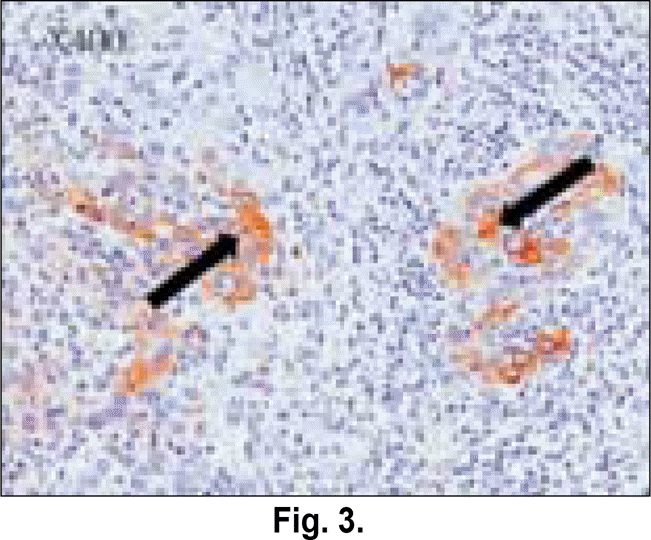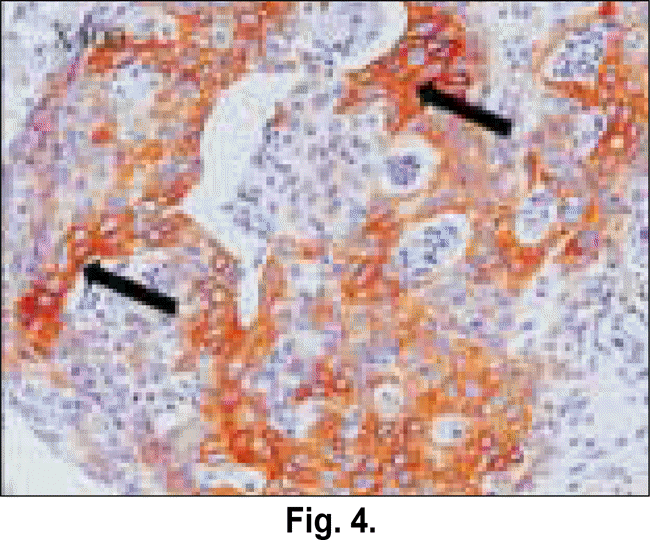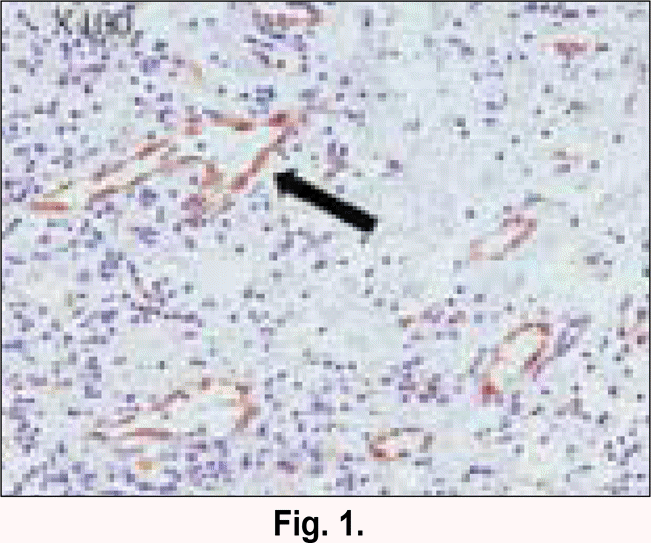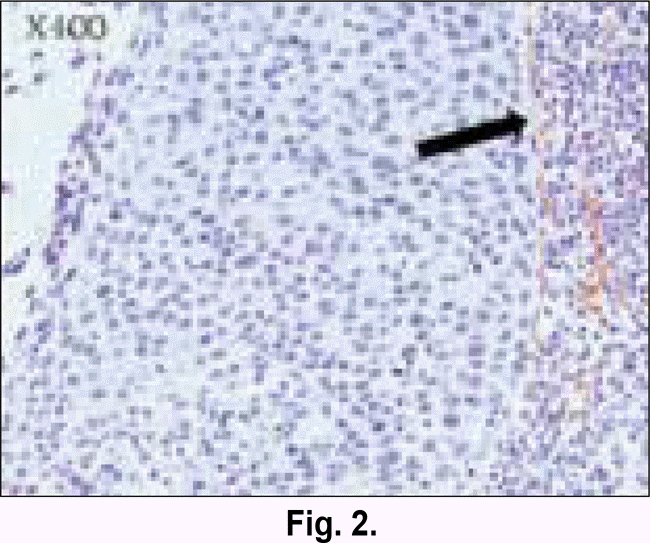Abstract
Purpose
Chemokines are structurally related, small polypeptide signaling molecules that bind to and activate a family of transmembrane G protein-coupled receptors, the chemokine receptors. Recently, interaction between the chemokine receptor CXCR4 and its ligand, stromal cell-derived factor 1 (SDF-1 or CXCL12), has been found to play an important role in tumorigenicity, proliferation, metastasis and angiogenesis in many cancers such as lung cancer, breast cancer, melanoma, glioblastoma, pancreatic cancer and cholangiocarcinoma.
Hence, the goal of this study is to identify the correlation of clinicopathological factors and the up-regulation of SDF-1 expression in oral squamous cell carcinoma.
Material and methods
We studied the immunohistochemical staining of SDF-1, quantitative RT-PCR (qRT-PCR) of SDF-1 gene in 20 specimens of 20 patients with oral squamous cell carcinoma.
Results
1. In the immunohistochemical study of poor differentiated and invasive oral squamous cell carcinoma, the high level staining of SDF-1 was observed. And the correlation between immunohistochemical SDF-1 expression and tumor nodes metastases (TNM) classification of specimens was significant.(x2 test, P < 0.05)
2. In the SDF-1 gene qRT-PCR analysis, SDF-1 expression was more in tumor tissue than in carcinoma in situ tissue. Paired-samples analysis determined the difference of SDF-1 mRNA expression level between the cancer tissue and the carcinoma in situ tissue.(Student's t-test, P < 0.05)
Go to : 
References
1. Sankaranarayanan R, Masuyer E, Swaminathan R, Ferlay J, Whelan S. Head and neck cancer: a global perspective on epidemiology and prognosis. Anticancer Res. 1998; 18:4779–86.
2. Parkin DM, Bray F, Ferlay J, Pisani P. Estimating the world cancer burden: Globocan 2000. Int J Cancer. 2001; 94:153–6.

3. Carvalho AL, Ikeda MK, Magrin J, Kowalski LP. Trends of oral and oropharyngeal cancer survival over five decades in 3267 patients treated in a single institution. Oral Oncol. 2004; 40:71–6.

4. Pisani P. Parkin DM, Bray F, Ferlay J. Estimates of the worldwide mortality from 25 cancers in 1990. Int J Cancer. 1999; 83:18–29.
5. Parkin DM, Pisani P, Ferlay J. Estimates of the worldwide incidence of 25 major cancers in 1990. Int J Cancer. 1999; 80:827–41.
6. Carvalho AL, Magrin J, Kowalski LP. Sites of recurrence in oral and oropharyngeal cancers according to the treatment approach. Oral Dis. 2003; 9:112–8.

7. Hemmer J, Kreidler J. Flow cytometric DNA ploidy analysis of squamous cell carcinoma of the oral cavity. Comparison with clinical staging and histologic grading. Cancer. 1990; 66:317–20.

8. Fernandez EJ, Lolis E. Structure, function, and inhibition of chemokines. Annu Rev Pharmacol Toxicol. 2002; 42:469–99.

10. Murdoch C, Finn A. Chemokine receptors and the role in inflammation and infectious diseases. Blood. 2000; 95:3032–43.
11. Hosokawa Y, Hosokawa I, Ozaki K, Nakae H, Murakami K, Miyake Y, et al. CXCL12 and CXCR4 expression by human gingival fibroblasts in periodontal disease. Clin Exp Immunol. 2005; 141:467–74.

12. Rossi D. Zlotnik A. The biology of chemokines and their receptors. Annu Rev Immunol. 2000; 18:217–42.
13. Mu ¨ller A, Homey B, Soto H, Ge N, Catron D, Buchanan M, et al. Involvement of chemokine receptors in breast cancer metastasis. Nature. 2001; 410:50–6.

14. Taichman RS, Cooper C, Keller ET, Pienta KJ, Taichman NS, McCauley LK. Use of the stromal cell-derived factor-1/CXCR4 pathway in prostate cancer metastasis to bone. Cancer Res. 2002; 62:1832–7.
15. Scotton CJ, Wilson JL, Milliken D, Stamp G, Balkwill FR. Epithelial cancer cell migration: a role for chemokine receptors? Cancer Res. 2001; 61:4961–5.
16. Uchida D, Begum NM, Almofti A, Nakashiro K, Kawamata H, Tateishi Y, et al. Possible role for stromal-cell-derived factor-1/CXCR4 signaling on lymph node metastasis of oral squamous cell carcinoma. Exp Cell Res. 2003; 290:289–302.
17. Bertolini F, Dell’ Agnola C, Mancuso P, Rabascio C, Burlini A, Monestiroli S, et al. CXCR4 neutralization, a novel therapeutic approach for non-Hodgkin’ s lymphoma. Cancer Res. 2002; 62:3106–12.
18. Murakami T, Maki W, Cardones AR, Fang H, Tun Kyi A, Nestle FO. Expression of CXC chemokine receptor-4 enhances the pulmonary metastatic potential of murine B16 melanoma cells. Cancer Res. 2002; 62:7328–34.
19. Ghadjar P, Coupland SE, Na IK, Noutsias M, Letsch A, Stroux A, et al. Chemokine receptor CCR6 expression level and liver metastases in colorectal cancer. J Clin Oncol. 2006; 24:1910–6.

20. Kang H, Watkins G, Parr C, Douglas-Jones A, Mansel RE, Jiang WG. Stromal cell derived factor-1: its influence on invasiveness and migration of breast cancer cells in vitro, and its association with prognosis and survival in human breast cancer. Breast Cancer Research. 2005; 7:R402–10.

21. Daly AJ, McIlreavey L, Irwin CR. Regulation of HGF and SDF-1 expression by oral fibroblasts-implications for invasion of oral cancer. Oral Oncol. 2008; 44:646–51.
22. Kim H, Muller WJ. The role of the epidermal growth factor receptor family in mammary tumorigenesis and metastasis. Exp Cell Res. 1999; 253:78–87.

23. Youngs SJ, Ali SA, Taub DD, Rees RC. Chemokines induce migrational responses in human breast carcinoma cell lines. Int J Cancer. 1997; 71:257–66.

24. Hill MW, Mackenzie IC. The influence of differing connective tissue substrates on the maintenance of adult stratified squamous epithelia. Cell Tissue Res. 1984; 237:473–8.

25. Mirshahi F. Pourtau J, Li H, Muraine M, Trochon V, Legrand E, et al. SDF-1 activity on microvascular endothelial cells: consequences on angiogenesis in in vitro and in vivo models. Thromb Res. 2000; 99:587–94.
26. Molino M, Woolkalis MJ, Prevost N, Pratico ′D, Barnathan ES, Taraboletti G, et al. CXCR4 on human endothelial cells can serve as both a mediator of biological responses and as a receptor for HIV-2. Biochim Biophys Acta. 2000; 1500:227–40.

27. Yang SX, Chen JH, Jiang XF, Wang QL, Chen ZQ, Zhao W, et al. Activation of chemokine receptor CXCR4 in malignant glioma cells promotes the production of vascular endothelial growth factor. Biochem Biophys Res Commun. 2005; 335:523–8.

28. Datta SR, Brunet A, Greenberg ME. Cellular survival: a play in three Akts. Genes Dev. 1999; 13:2905–27.

29. Evan GI, Vousden KH. Proliferation, cell cycle and apoptosis in cancer. Nature. 2001; 411:342–8.

30. Dewan MZ, Ahmed S, Iwasaki Y, Ohba K, Toi M, Yamamoto N. Stromal cell-derived factor-1 and CXCR4 receptor interaction in tumor growth and metastasis of breast cancer. Biomed Pharmacother. 2006; 60:273–6.
Go to : 
 | Fig. 3.Immunohistochemical staining for SDF-1 of moderate differentiated oral squamous cell carcinoma.(×400) |
 | Fig. 4.Immunohistochemical staining for SDF-1 of poor differentiated and invasive oral squamous cell carcinoma.(×400) (SDF-1: stromal cell-derived factor-1) |
Table 1.
The correlation between immunohistochemica SDF-1 expression and clinical and pathological factors.
| Variable | Case (n) |
SDF-1 positive expression |
||
|---|---|---|---|---|
| n (%) | x2 | P | ||
| Sex | ||||
| Male | 11 | 5 (45.5%) | 0.303 | 0.582 |
| Female | 9 | 3 (33.3%) | ||
| Age | ||||
| 60 ≤ | 5 | 1 (20.0%) | 1.111 | 0.292 |
| 60 > | 15 | 7 (46.7%) | ||
| Histological differentiation | ||||
| Well | 13 | 4 (30.8%) | 1.319 | 0.251 |
| Moderate/Poor | 7 | 4 (57.1%) | ||
| Tumor size | ||||
| T1/T2 | 11 | 2 (18.2%) | 4.848 | 0.028* |
| T3/T4 | 9 | 6 (66.7%) | ||
| Nodal status | ||||
| N (-) | 11 | 2 (18.2%) | 4.848 | 0.028* |
| N (+) | 9 | 6 (66.7%) | ||
| Metastasis | ||||
| M (-) | 17 | 5 (29.4%) | 5.294 | 0.021* |
| M (+) | 3 | 3 (100%) | ||
| TNM stage | ||||
| I/II | 8 | 1 (12.5%) | 4.201 | 0.040* |
| III/IV | 12 | 7 (58.3%) | ||
Table 2.
Relationship between relative levels of SDF-1 mRNA (SDF-1/GAPDH) and clinical and pathological factors.




 PDF
PDF ePub
ePub Citation
Citation Print
Print




 XML Download
XML Download